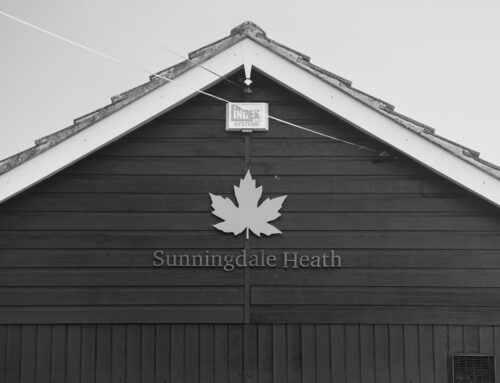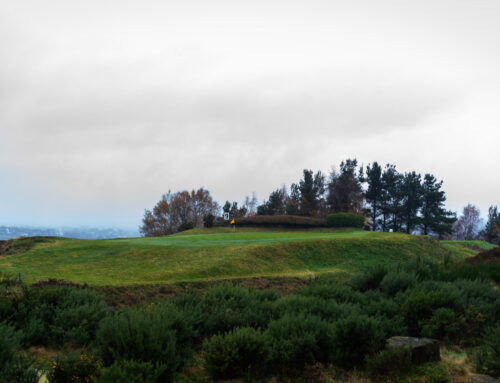Tom Simpson used to say the best holes were the ones that caused the tiger (scratch man) pain and the rabbit (bogey golfer) pleasure.
I play my golf at Portmarnock Golf Club (PGC) in Dublin and when I play alone, I often start on the 10th, my favourite hole on the course. Royal St. George’s (RSG) 10th hole has often been my starting hole in matches at RSG. Walking up the 10th at RSG I remember admiring the magnificence of the green with my opponent Dr. Alistair Wells (uncle of Nicola – 5* podcast guest) which falls off mostly on all sides, with some reprieve on the right. The green is hard to hit – cold and blustery conditions are the staple accompaniments of holes like this and make the hitting of the green a celebration. Both holes are an allegory for links golf really – freedom is achieved when you don’t tie outcome to your perfect shot; a game of precision where sometimes that isn’t even enough if the bounce is against you.

10th at RSG- Simon Haines/ @Hainesy76
Back in Dublin, I’ve coaxed something off the 10th tee to 120 yards out and awaiting is a magnificent green tilting back right to front left, a sheer fall off and a single pot bunker on the right. The tie in of this right bunker with the fall offs on the front and mid-left of the green is near perfection. How you must get your shot over the front bunker and yet not fall victim to the dangers of the left is the beauty of the strategy; they are separate but linked, woven gently together by a central safe area on the green about the size of a mini cooper.

10th green at Portmarnock in distance with nature of tilt and fall offs evident. Adam Toth (Instagram: @atothphotography)
The wind rarely stays in bed on the Portmarnock peninsula and the prevailing wind is off the right; the shot demands a hold up fade with a wedge, preferably at Adam’s apple height. A ball hitting anywhere left of centre of the green will find a home in the left swales and it’s hard to know which is worse- the front right bunker or a ball that bounces off the right bank and careers away.
This is similar to a green design concept fleshed out by the guys at the Fried Egg in their video volcano hole but Top Hat nomenclature suits us better here in GB&I. Their video gives an overview of the history of the volcano hole and as with lots of golf architecture and iconic holes, there is a search for a model or template hole from which the volcano originated. The difference is the 10th at PGC is no simulacra of any hole- there is nothing like it that I have seen.
If the hole sounds proscriptive in demanding a hold up fade or whatever the wind of the day is calling for, remember it is anything but: Simpson’s rabbit can bunt his way up the left hand side of the 10th at PGC if he wants- no greenside bunker awaits and the left greenside swale is a gentle one to putt from.

10th green at Portmarnock. Adam Toth (Instagram: @atothphotography)
The 10th at PGC is not long at 370 yards and offers the chance to leave an approach short left in a puttable sanctuary for the bogey golfer, as mentioned. The 10th at RSG is less favourably disposed to a run up shot and has two bunkers on either side of the green. The fall offs at RSG are more dramatic but there is less tilt on the green itself, and a ball hitting it will generally settle there. Overall, its more taxing on the legs than the 10th at PGC, being longer and more uphill, and maybe a little less taxing on the brain, but it’s a real beauty.
The 10th hole at RSG is Laidlaw Purves design: the eye surgeon from Wimbledon GC was not myopic and spotted the potential in the dunes when peering through the glass windows of St Clement’s Church in Sandwich. Purves was a remarkable character who died aged 50 when a member of 32 golf clubs. He was instrumental in founding the Ladies Golf Union (1893) and came up with the method for modern handicapping (1898). There was nothing wrong with his eyesight nor his design ability, but he designed RSG very much in the penal Victorian style of golf and this was to come under pressure not long after creation: his original 10th green was moved to its current location on the highest point on the course in preparation for the 1911 Open Championship. This was an interesting watershed time in golf architecture; John Low and pals were beating the drums of change and using RSG and its innumerable cross bunkers and forced carries as the epitome of the unjust Victorian style.
At PGC the current 10th was instigated by Harry Colt’s partner John Morrison in the 1950s. He had visited in the 30s and made recommendations which weren’t actioned till the 50s. Remarkably the 10th green used to be played to as the 8th green from almost the opposite direction; inconceivably difficult with the green tilted running across and away from your approach. Harry Bradshaw the Ryder Cupper and loser of a playoff for the 1949 Open to Bobby Locke was the long-time Pro at PGC and said the infrequent winter east wind was ‘no good for man or beast’. Should I get a winters day at Portmarnock where the cold easterly has caused an empty course, I might just sneak an approach at the 10th green from the 8th fairway.
The 10th at PGC is fairer for the average golfer, shorter, and arguably a harder birdie, than the 10th at RSG. The high approach shot being tested at RSG has become easier for good players over time. Both holes are magnificent, but the author is biased and Morrison’s masterpiece has stolen his heart. Skyline/horizon/infinity/plateau/volcano? Top Hat for these old classics I think.
Darragh Garrahy






